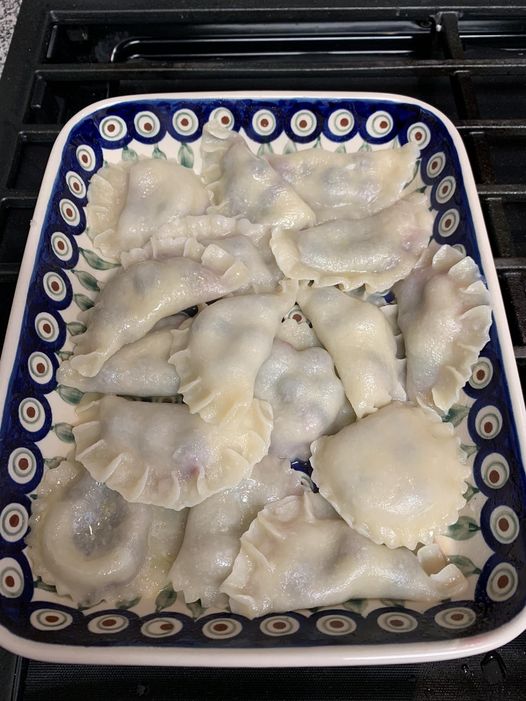Why I Love This Recipe:
This perogie dough recipe is one of my favorites because it’s incredibly easy to work with and always results in soft, tender dough. I love that it doesn’t require rolling out circles and that I never have dough scraps to deal with—everything is used! It’s a great way to ensure your dough stays soft and doesn’t become tough, and the rest time allows the flavors to meld beautifully. Every time I make this dough, I get the perfect perogies that everyone enjoys.
Ingredients:
- 6 cups all-purpose flour
- 1 teaspoon salt
- 1 cup butter or margarine, room temperature
- 2 eggs
- 4 tablespoons full-fat sour cream or plain Greek yogurt
- 1 1/2 cups potato water, room temperature
Instructions:
- Mix the Dry Ingredients: In a large bowl, combine the flour and salt. Add the room temperature butter or margarine and mix until it resembles crumbs, similar to making pie dough.
- Prepare the Wet Ingredients: In a separate bowl, beat the eggs and add the sour cream (or Greek yogurt). Stir until smooth.
- Combine Wet and Dry Ingredients: Gradually add the wet ingredients to the dry ingredients. Mix until everything is well combined. The dough will be smooth but should not be kneaded—just ensure all the ingredients are thoroughly mixed.
- Add Potato Water: Pour in the potato water and mix until the dough comes together. Ensure the dough is smooth and cohesive.
- Rest the Dough: Cover the dough and let it rest for about 1 hour at room temperature. This allows the dough to relax and become easier to work with.
- Shape the Dough: After the dough has rested, take small pieces of the dough, roll them into ropes, and cut them into 1/2-inch pieces. Roll each piece out to your desired thickness, add your filling, and fold to form the perogies.
- Cook: Boil the perogies in a pot of salted water until they float (about 3-5 minutes). Then, you can fry them in butter for a crispy finish, if desired.
Tips & Tricks:
- Resting the Dough: Resting the dough is key to achieving the soft texture. Don’t skip this step—let the dough relax for about an hour before working with it.
- Handling the Dough: Avoid overworking the dough, especially when rolling it out. The more flour you use while rolling, the tougher the dough may become.
- No Scraps: I don’t roll out the dough into circles, which prevents any dough scraps. Instead, I cut my dough into 1/2-inch pieces and roll them out individually. This ensures all dough is used!
- Using a Mixer: If you prefer to use a mixer, use the lowest speed and mix until the dough just comes together. Overmixing will cause the dough to shrink when rolled.
FAQs:
Can I use margarine instead of butter? Yes, margarine works well in this recipe. The texture may vary slightly, but the dough will still be soft and easy to work with.
What can I use instead of sour cream? Plain Greek yogurt is a great substitute if you prefer it or don’t have sour cream on hand.
Can I make this dough ahead of time? Yes! You can refrigerate the dough for up to 2 days. Just be sure to let it come to room temperature before working with it.
Why should I not knead the dough? Kneading the dough can cause it to become tough. This recipe relies on gently mixing the ingredients to maintain the soft, tender texture.
Storage:
Once you’ve filled and shaped your perogies, they can be stored in the freezer for later use. Simply place them on a baking sheet in a single layer to freeze them, then transfer to an airtight container or freezer bag. When ready to cook, you can boil them directly from frozen!
